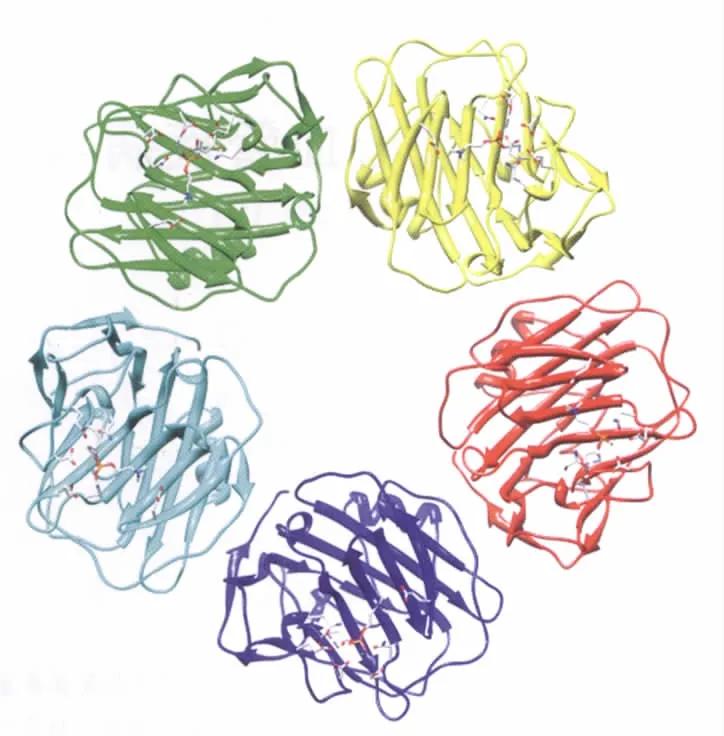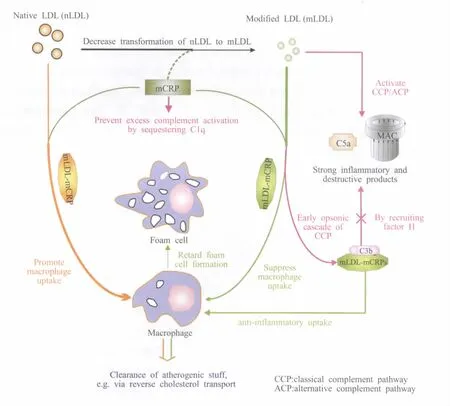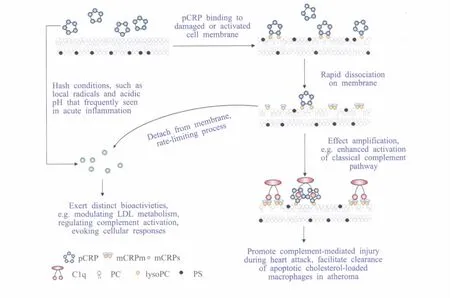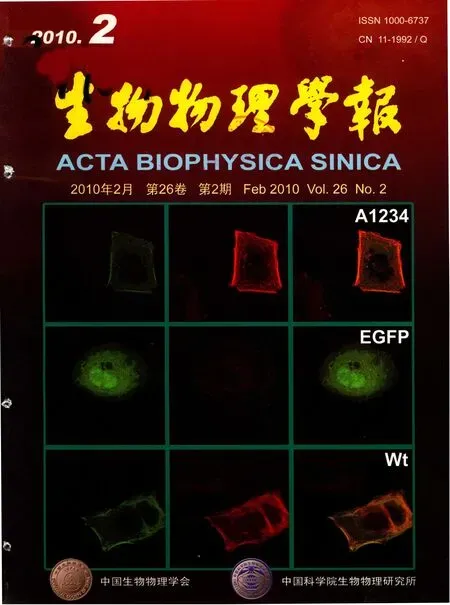C-反应蛋白
——关联心血管疾病与炎症的重要分子
赵晶,吉尚戎,武一
兰州大学生命科学学院,兰州730000
C-反应蛋白
——关联心血管疾病与炎症的重要分子
赵晶,吉尚戎,武一
兰州大学生命科学学院,兰州730000
炎症在心血管疾病(cardiovascular disease,CVD)的各个阶段中均发挥着重要作用。C-反应蛋白(C-reactive protein,CRP)是一种典型的人类急性期蛋白,由5个相同的亚基构成,在临床上被广泛用作炎症的非特异性标识物。近年的研究显示,CRP不仅是CVD发病风险的灵敏标识,而且直接参与调控与CVD相关的炎症过程。基于对已有研究发现的回顾和分析,文章指出CRP的单体形式(monomeric CRP,mCRP)是调控局部炎症过程的主要CRP异构体。
心血管疾病;C-反应蛋白;炎症
0 引言
C-反应蛋白(C-reactive protein,CRP)广泛存在于脊椎动物和无脊椎动物中,其结构和序列在进化中高度保守,暗示这种蛋白具有重要的生物学意义[1,2]。CRP与SAP、PTX3同属五聚体蛋白(pentraxin)家族[1~5],由5个相同亚基以非共价方式组装而成(图1)。CRP通过其配体结合面识别多种保守的自体或异体分子模式,如凋亡或受损的细胞膜、细菌壁、脂质、多糖、核酸等;在与配体结合后,CRP的效应分子结合面可接着与补体组分(C1q、C4BP、FH等)或细胞受体(FcγR、清道夫受体等)相互作用,从而激活和调控补体途径,促进受损细胞或病原体的高效清除,并可激发多种细胞应答,其行为非常类似于在先天免疫中发挥关键作用的模式识别受体(pattern recognition receptor)。因此,一般认为CRP主要在炎症、宿主防御和免疫调节等过程中发挥作用[1~4]。由于在人类中还未发现CRP缺失或氨基酸序列突变,而敲除CRP基因的恰当动物模型也尚未建立,因此这种古老蛋白的确切生物学功能还有待进一步研究[1,2]。

图1 C-反应蛋白五聚体的X-射线晶体结构图中显示的为配体结合面,与其相对的背面为效应分子结合面Fig.1The X-ray crystal structure of C-reactive proteinThe shown view is the ligand binding face,while the effctor binding face is on the opposite
1 CRP与心血管疾病
CRP是一种典型的人类急性期蛋白,主要由肝脏合成。当机体遭受组织损伤或病毒侵染时,CRP的血浆浓度会迅速升高,因而在临床上被广泛用作炎症的非特异性标识物[1]。心血管疾病(cardiovascular disease,CVD)是对人类健康威胁最为严重的疾病之一,其致病主因为动脉粥样硬化(atherosclerosis,AS)。由于炎症在AS病理过程的各个阶段中均发挥着主导作用[6,7],因此,包括CRP在内的重要炎症因子在CVD风险预测及致病机理中作用的研究,获得了广泛关注。近20年的大量流行病学调查研究显示,CRP血浆水平的(微小)差异是CVD的发病风险、严重程度及预后状况的灵敏标识[1,4,8]。在某些研究中,其预测灵敏度甚至高于传统的CVD风险因子——血脂水平[9];而在中国[10]及日本[11]等东亚人群中,CRP风险限似乎更为敏感。2003年初,美国疾控与预防中心和心脏病学会建议将高敏CRP水平纳入临床CVD风险评估。最近,CRP及炎症在CVD中的关键作用再次被大规模临床研究所证实[12,13],相关发现被美国《时代周刊》评选为2008年十大医学突破第二位。
值得注意的是,缓解CVD进程的治疗效果(如动脉硬化斑块尺寸缩小或增长减缓)与CRP水平的同步变化直接相关[14,15],而以CRP水平为参考进行的早期干预则使血脂正常受试者的CVD发病风险减半[13]。此外,CRP在AS的初期病灶中即可被检测到,其分布模式和强度与疾病发展紧密相关,且与多种AS致病分子(如被氧化或酶解的低密度脂蛋白、补体等)共定位。这些发现均支持CRP不仅是CVD的风险标识,而且直接参与了CVD的病生理过程。后者事实上已成为领域内近期关注的热点问题之一,超过2/3的CRP研究论文发表于近10年间。大量的离体和在体基础研究均指出,CRP能够调控与CVD炎症相关的诸多方面[1~5]。因此,除了作为CVD风险早期筛查的可靠标识外,CRP还极有可能成为治疗相关疾病的新标靶。例如,在CVD急性终末事件(心肌梗塞)中,CRP主要通过激活补体途径介导组织损伤[16,17],因此阻抑CRP的配体结合或与补体组分的相互作用均可作为候选的干预策略。与此相符,在大鼠心肌梗塞模型中,针对CRP的配体结合位点的小分子抑制剂的确能够显著减少心肌损伤[17]。
但另一方面,CRP在CVD慢性病理过程中所扮演的角色却存在着很大争议[1,2,18,19],这无疑阻碍了以CRP作为标靶的早期治疗策略的开发——对于CVD这类慢性发展但急性发作的高致死、致残性疾病而言,早期干预显然具有更为重要的现实意义。阐明CRP的确切作用需解决三个关键争议。首先,介导CRP生物学活性的细胞受体主要为FcγR[1~4],该受体广泛表达于多种血管细胞和循环细胞表面。那么作为一种急性期蛋白,CRP是怎样精细调控细胞(炎性)行为,而机体又如何适应此蛋白超过1,000倍的血浆浓度的波动(<1 μg/mL→>500 μg/mL)[1,2]?其次,CRP诱导细胞应答往往需要高浓度(>25 μg/mL)和长作用时间[3,20],这难以解释其水平的微小升高(3 μg/mL)与疾病风险预测之间的强相关性。其三,在离体和在体研究体系中,充斥着关于CRP活性的大量相互矛盾的报道。例如,在离体细胞应答研究中,CRP究竟如何调控eNOS的活性[21~24]?在小鼠或兔AS模型中,转基因CRP到底是杀手[25]、保护者[26]还是旁观者[27~29]?而在人体中,(外源注射)上调的CRP是诱导促炎[30,31]抑或是抗炎[2,21]应答?
2 CRP变构及其在CVD炎症中的作用
前述矛盾无法简单地归因于实验体系差异或外源“污染”(如内毒素、叠氮化物[22]);相反,某种活性显著增强的CRP变体形式的存在与否及水平高低或许是更合理的解释。1983年,Potempa等人[32]通过脲、酸或热处理使CRP五聚体解聚,从而首次获得了CRP的亚基形式(monomeric CRP,mCRP)。mCRP丧失了CRP五聚体中的亚基结构,表现出截然不同的构象特征及抗原表位[32,33]。与低密度脂蛋白(low-density lipoprotein)[34,35]和补体系统[36,37]的相互作用,被认为是CRP参与AS进程的重要事件。但通过仔细控制蛋白异构状态,我们发现mCRP具有明显更高效灵活地识别LDL变体[38]、调控补体系统激活[39]及LDL代谢[38]的能力,而原先报道的CRP相关活性则很可能源于样品中的mCRP“掺杂”[39]。这些发现支持mCRP可通过调控LDL代谢和补体活化而直接参与AS炎症过程的推断(图2)。此外,mCRP还是多种细胞炎性应答的强刺激分子[20,40~46]:低浓度的mCRP(1 μg/mL)在短时间内(4 h)即能显著上调内皮细胞的炎性细胞因子表达[20,42]。因此,mCRP很可能代表着一种活性显著增强的“功能态”CRP变体。

图2 mCRP在早期AS病灶中调控LDL代谢及补体激活的模式图Fig.2The regualtion of mCRP on LDL metabolism and complement activation in early AS lesions
然而,CRP五聚体的结构异常稳定,制备mCRP往往需要激烈的变性处理,“功能态单体”的生物学意义因此受到强烈质疑[1,2,5,18]。炎症过程中会发生大量细胞死亡,而因凋亡或坏死受损的生物膜则是CRP发挥功能的主要靶点[1]。通过电镜成像、抗原新表位表达以及免疫荧光共定位等手段,我们发现CRP与受损生物膜的结合会诱导其到mCRP的快速转化,而此解聚过程同时伴随着其补体激活和细胞刺激效能的显著增强[20]。最近,Eisenhardt等人[41]在激活的血小板膜上也获得了类似的结果。此外,中度酸化及氧化压力等常见的炎症条件亦能促进CRP到mCRP的异构切换(未发表数据)。这些工作因而描述了一种由炎症微环境驱动的CRP异构切换机制(图3),同时也建立了mCRP作为一种CRP天然异构体参与调控炎症过程的概念[3,47]。事实上,在多种炎症疾病中均可检测到mCRP自体抗体,且其水平亦与疾病严重程度相关[48~50]。我们因而提出:单体异构体mCRP是参与CVD炎症调控的主要功能态异构体,而五聚体形式CRP则主要作为mCRP前体及炎症严重程度的标识物。

图3 炎性微环境调控CRP变构及活性变化的模式图Fig.3TheregualtionofthestructureandbioactivitiesofmCRPbyinflammatory microenvironment
由于“静息态”CRP必须经过急性或慢性炎症微环境的调制才能转化为“功能态”mCRP,这一方面使CRP的表观浓度与实际起效的mCRP水平不直接相关,而另一方面则使mCRP的效应限于局部病灶,从而避免了因CRP浓度的大幅波动而导致的系统性过度刺激。因此,从五聚体到单体的构象切换不但是一个激活过程,而且还代表着一种缓冲机制——这很好地解释了“CRP这种急性期蛋白是怎样精细调控细胞应答,而机体又是如何适应此蛋白可达上千倍的血浆浓度波动”。而此激活-缓冲机制的重要推论之一为:mCRP主要应在局部炎症病灶中积累和发挥作用。事实上,在多种人类癌症(Potempa博士,未发表数据)、肾炎[51]、AS斑块[41]、脑梗[46]等病灶组织中存在的主要为mCRP而非CRP。值得注意的是,上述机制还指出,CRP异构体在疾病过程中所扮演的角色与特定的病理条件密切相关。因此,先前关于CRP行为相互矛盾的发现,很可能是因为未曾严格区分两种异构体的活性[21~24,30,31]或未仔细分析疾病模型条件[25~28]所致。
在上述的两态模型中,CRP到mCRP的受控变构以及mCRP发挥作用的方式,显然是决定其在CVD炎症过程中所扮演角色的关键。在血栓形成、心肌梗塞等CVD终末急性炎症事件中,CRP水平迅速升高,而血管内活化的血小板或心脏中因缺氧造成的细胞坏死又为CRP变构提供了丰富的受损膜配体[20],这使得病灶处短期内即积累大量“活性态”mCRP,从而介导嗜中性粒细胞[44,45,52,53]、血小板[43]、单核细胞[41]以及补体[20,38]等的过度活化,促进炎症恶化。在这种情况下,阻抑CRP到mCRP的变构无疑有助于缓解恶性后果——事实上,这很可能是针对CRP配体结合位点的小分子抑制剂减少心肌损伤[17]的机制之一。与此相反,在CVD等疾病的慢性发展过程中,CRP水平仅有少量上升,而病灶微环境常为“局部胁迫”[54],mCRP的变构效率较低。此时,mCRP很可能通过调控LDL代谢[38,55]、激活补体途径的前期非炎性调理阶段[55~58]、压制泡细胞形成[38,59]等,发挥阻抑炎症进展的活性。与此相符,在ApoE(-/-)小鼠模型中,低水平mCRP处理对早期AS具有保护效应[60]。
随着mCRP在炎症调控中重要性的逐渐显现,它在炎症不同方面发挥作用的分子机制也开始引起研究者的关注。有意思的是,虽然mCRP所启动的细胞应答及相应的胞内信号转导途径很快即被阐明,但介导mCRP效应的细胞感受器却长期未被鉴定。虽然CD16曾被报道为mCRP的受体[61],但阻抑实验表明,mCRP对嗜中性粒细胞[45]、内皮细胞[20,42]、血小板[43]、单核细胞[41]等的作用,只与CD16(少)部分相关或不相关。我们最近发现mCRP主要通过胆固醇识别序列和C端八肽,与内皮细胞膜中富含胆固醇的脂筏微区直接相互作用,从而启动相应的生物学效应[40]。这种受体非依赖性的、脂筏介导的效应,在树突状细胞对尿酸等物质的应答中亦有报道[62]。考虑到脂筏在细胞信号转导中的中心作用及普遍分布[63,64],脂筏很可能是介导mCRP效应的主要感受器。事实上,最近其他小组的独立工作也已证明,mCRP主要通过脂筏启动单核细胞[41]和血小板[65]应答。由于他汀类化合物可能通过结合胆固醇或降低胆固醇含量而影响脂筏功能,这种药物对CVD的疗效与CRP风险水平之间的密切关联[13~15,66,67]显得尤其有趣。
3 结语
从作为炎症标识的静息态CRP到实际参与炎症过程的功能态mCRP的变构切换,使得这种急性期蛋白能够在不同病生理条件下有控地发挥活性,从而能够作为炎症的精细调控因子。虽然关于mCRP的生物学意义曾有长期争论[1,2,5,18],但近年的研究逐步揭示了mCRP的生成途径[20,41]、mCRP对体液免疫及炎症过程的调控[20,38~40,42~46,52,53]、多种疾病中mCRP自体抗体的产生[48~50],以及mCRP在病灶组织中的存在[41,46,51]。这些发现逐渐建立了mCRP作为一种CRP天然异构体参与调控炎症过程的概念[3,47]。干预CRP的解聚及mCRP发挥作用的途径,显然是CVD治疗策略设计的可能候选。但由于mCRP的具体贡献依赖于炎症微环境,对其在不同病生理条件下发挥作用的分子机制的清晰认识,是设计和选择恰当干预措施的前提,而现有理解远无法满足这样的需求。建立将mCRP作为疾病标识的(直接或间接)检测手段并建立其与疾病进程之间的关联,解析mCRP行为的结构基础,系统描述不同细胞类型对mCRP的短期和长期应答谱,进一步发现脂筏中介导mCRP下游效应的伴侣分子等,都将是非常迫切需要回答的问题。
1.Pepys MB,Hirschfield GM.C-reactive protein:a critical update.J Clin Invest,2003,111(12):1805~1812
2.Casas JP,Shah T,Hingorani AD,Danesh J,Pepys MB. C-reactive protein and coronary heart disease:a critical review.J Intern Med,2008,264(4):295~314
3.Schwedler SB,Filep JG,Galle J,Wanner C,Potempa LA. C-reactiveprotein:afamilyofproteinstoregulate cardiovascular function.Am J Kidney Dis,2006,47(2): 212~222
4.Singh SK,Suresh MV,Voleti B,Agrawal A.The connection between C-reactive protein and atherosclerosis.Ann Med, 2008,40(2):110~120
5.Verma S,Devaraj S,Jialal I.C-Reactive protein promotes atherothrombosis.Circulation,2006,113(17):2135~2150
6.Ross R.Atherosclerosis——an inflammatory disease.N Engl J Med,1999,340(2):115~126
7.Glass CK,Witztum JL.Atherosclerosis,the road ahead. Cell,2001,104(4):503~516
8.Kaptoge S,Di Angelantonio E,Lowe G,Pepys MB, Thompson SG,Collins R,Danesh J.C-reactive protein concentration and risk of coronary heart disease,stroke, andmortality:anindividualparticipantmeta-analysis. Lancet,2010,375(9709):132~140
9.Ridker PM,Rifai N,Rose L,Buring JE,Cook NR. Comparison of C-reactive protein and low-density lipoprotein cholesterol levels in the prediction of first cardiovascular events.N Engl J Med,2002,347(20):1557~1565
10.Jiang S,Bao Y,Hou X,Fang Q,Wang C,Pan J,Zuo Y, Zhong W,Xiang K,Jia W.Serum C-reactive protein and riskofcardiovasculareventsinmiddle-agedandolder chinesepopulation.AmJCardiol,2009,103(12): 1727~1731
11.Iso H,Cui R,Date C,Kikuchi S,Tamakoshi A.C-reactive proteinlevelsandriskofmortalityfromcardiovascular disease in Japanese:the JACC study.Atherosclerosis, 2009,207(1):291~297
12.Ridker PM,Paynter NP,Rifai N,Gaziano JM,Cook NR. C-reactiveproteinandparentalhistoryimproveglobal cardiovascular risk prediction:the reynolds risk score for men.Circulation,2008,118(22):2243~2251
13.Ridker PM,Danielson E,Fonseca FA,Genest J,Gotto AM,Jr Kastelein JJ,Koenig W,Libby P,Lorenzatti AJ, MacFadyen JG,Nordestgaard BG,Shepherd J,Willerson JT,Glynn RJ.Rosuvastatin to prevent vascular events in men and women with elevated C-reactive protein.N Engl J Med,2008,359(21):2195~2207
14.Ridker PM,Cannon CP,Morrow D,Rifai N,Rose LM, McCabe CH,Pfeffer MA,Braunwald E.C-reactive protein levels and outcomes after statin therapy.N Engl J Med, 2005,352(1):20~28
15.Nissen SE,Tuzcu EM,Schoenhagen P,Crowe T,Sasiela WJ,Tsai J,Orazem J,Magorien RD,O'Shaughnessy C, Ganz P.Statin therapy,LDL cholesterol,C-reactive protein, and coronary artery disease.N Engl J Med,2005,352(1): 29~38
16.Griselli M,Herbert J,Hutchinson WL,Taylor KM,Sohail M, Krausz T,Pepys MB.C-reactive protein and complement areimportantmediatorsoftissuedamageinacute myocardialinfarction.JExpMed,1999,190(12): 1733~1740
17.Pepys MB,Hirschfield GM,Tennent GA,Gallimore JR, Kahan MC,Bellotti V,Hawkins PN,Myers RM,Smith MD, Polara A,Cobb AJ,Ley SV,Aquilina JA,Robinson CV, Sharif I,Gray GA,Sabin CA,Jenvey MC,Kolstoe SE, Thompson D,Wood SP.Targeting C-reactive protein for the treatment of cardiovascular disease.Nature,2006, 440(7088):1217~1221
18.SepulvedaJL,MehtaJL.C-reactiveproteinand cardiovasculardisease:acriticalappraisal.CurrOpin Cardiol,2005,20(5):407~416
19.Scirica BM,Morrow DA.Is C-reactive protein an innocent bystander or proatherogenic culprit?The verdict is still out. Circulation,2006,113(17):2128~2134
20.Ji SR,Wu Y,Zhu L,Potempa LA,Sheng FL,Lu W,Zhao J.Cell membranes and liposomes dissociate C-reactive protein(CRP)to form a new,biologically active structural intermediate:mCRP(m).FASEB J,2007,21(1):284~294
21.Clapp BR,Hirschfield GM,Storry C,Gallimore JR,Stidwill RP,Singer M,Deanfield JE,MacAllister RJ,Pepys MB, Vallance P,Hingorani AD.Inflammation and endothelial function:direct vascular effects of human C-reactive protein on nitric oxide bioavailability.Circulation,2005,111(12): 1530~1536
22.Taylor KE,Giddings JC,van den Berg CW.C-reactive protein-inducedinvitroendothelialcellactivationisan artefactcausedbyazideandlipopolysaccharide. Arterioscler Thromb Vasc Biol,2005,25(6):1225~1230
23.Devaraj S,Du Clos TW,Jialal I.Binding and internalization of C-reactive protein by Fcgamma receptors on human aorticendothelialcellsmediatesbiologicaleffects. Arterioscler Thromb Vasc Biol,2005,25(7):1359~1363
24.Schwartz R,Osborne-Lawrence S,Hahner L,Gibson LL, GormleyAK,VongpatanasinW,ZhuW,WordRA, Seetharam D,Black S,Samols D,Mineo C,Shaul PW. C-reactive protein downregulates endothelial NO synthase and attenuates reendothelializationin vivoin mice.Circ Res,2007,100(10):1452~1459
25.Paul A,Ko KW,Li L,Yechoor V,McCrory MA,Szalai AJ, Chan L.C-reactive protein accelerates the progression of atherosclerosisinapolipoproteinE-deficientmice. Circulation,2004,109(5):647~655
26.Kovacs A,Tornvall P,Nilsson R,Tegner J,Hamsten A, BjorkegrenJ.HumanC-reactiveproteinslows atherosclerosisdevelopmentinamousemodelwith human-like hypercholesterolemia.Proc Natl Acad Sci USA, 2007,104(34):13768~13773
27.Hirschfield GM,Gallimore JR,Kahan MC,Hutchinson WL, Sabin CA,Benson GM,Dhillon AP,Tennent GA,Pepys MB.TransgenichumanC-reactiveproteinisnot proatherogenic in apolipoprotein E-deficient mice.Proc Natl Acad Sci USA,2005,102(23):8309~8314
28.Tennent GA,Hutchinson WL,Kahan MC,Hirschfield GM, Gallimore JR,Lewin J,Sabin CA,Dhillon AP,Pepys MB. TransgenichumanCRPisnotpro-atherogenic, pro-atherothrombotic or pro-inflammatory in apoE-/-mice. Atherosclerosis,2008,196(1):248~255
29.Koike T,Kitajima S,Yu Y,Nishijima K,Zhang J,Ozaki Y, Morimoto M,Watanabe T,Bhakdi S,Asada Y,Chen YE, FanJ.HumanC-reactiveproteindoesnotpromote atherosclerosisintransgenicrabbits.Circulation,2009, 120(21):2088~2094
30.Bisoendial RJ,Kastelein JJ,Levels JH,Zwaginga JJ,van den Bogaard B,Reitsma PH,Meijers JC,Hartman D,Levi M,Stroes ES.Activation of inflammation and coagulation after infusion of C-reactive protein in humans.Circ Res, 2005,96(7):714~716
31.van Leuven SI,Birjmohun RS,Franssen R,Bisoendial RJ, de Kort H,Levels JH,Basser RL,Meijers JC,Kuivenhoven JA,Kastelein JJ,Stroes ES.ApoAI-phosphatidylcholine infusionneutralizestheatherothromboticeffectsof C-reactive protein in humans.J Thromb Haemost,2008, 7(2):347~354
32.Potempa LA,Maldonado BA,Laurent P,Zemel ES, Gewurz H.Antigenic,electrophoretic and binding alterations ofhumanC-reactiveproteinmodifiedselectivelyinthe absenceofcalcium.MolImmunol,1983,20(11): 1165~1175
33.Potempa LA,Siegel JN,Fiedel BA,Potempa RT,Gewurz H.Expression,detectionandassayofaneoantigen (Neo-CRP)associatedwithafree,humanC-reactive protein subunit.Mol Immunol,1987,24(5):531~541
34.de Beer FC,Soutar AK,Baltz ML,Trayner IM,Feinstein A,Pepys MB.Low density lipoprotein and very low density lipoprotein are selectively bound by aggregated C-reactive protein.J Exp Med,1982,156(1):230~242
35.ChangMK,BinderCJ,TorzewskiM,WitztumJL. C-reactive protein binds to both oxidized LDL and apoptotic cellsthroughrecognitionofacommonligand: phosphorylcholine of oxidized phospholipids.Proc Natl Acad Sci USA,2002,99(20):13043~13048
36.Bhakdi S,Torzewski M,Paprotka K,Schmitt S,Barsoom H,Suriyaphol P,Han SR,Lackner KJ,Husmann M. PossibleprotectiveroleforC-reactiveproteinin atherogenesis:complement activation by modified lipoproteins haltsbeforedetrimentalterminalsequence.Circulation, 2004,109(15):1870~1876
37.Torzewski J,Torzewski M,Bowyer DE,Frohlich M,Koenig W,WaltenbergerJ,FitzsimmonsC,HombachV. C-reactive protein frequently colocalizes with the terminal complement complex in the intima of early atherosclerotic lesions of human coronary arteries.Arterioscler Thromb Vasc Biol,1998,18(9):1386~1392
38.Ji SR,Wu Y,Potempa LA,Qiu Q,Zhao J.Interactions of C-reactive protein with low density lipoproteins:implications foranactiveroleofmodifiedC-reactiveproteinin atherosclerosis.Int J Biochem&Cell Biol,2006,38(4): 648~661
39.Ji SR,Wu Y,Potempa LA,Liang YH,Zhao J.Effect of modified C-reactive protein on complement activation.A possiblecomplementregulatoryroleofmodifiedor monomericC-reactiveproteininatheroscleroticlesions. Arterioscler Thromb Vasc Biol,2006,26(4):935~941
40.Ji SR,Ma L,Bai CJ,Shi JM,Li HY,Potempa LA,Filep JG,Zhao J,Wu Y.Monomeric C-reactive protein activates endothelial cells via interaction with lipid raft microdomains. FASEB J,2009,23(1):1806~1816
41.Eisenhardt SU,Habersberger J,Murphy A,Chen YC, Woollard KJ,Bassler N,Qian H,von Zur Muhlen C, Hagemeyer CE,Ahrens I,Chin-Dusting J,Bobik A,Peter K.DissociationofpentamerictomonomericC-reactive proteinonactivatedplateletslocalizesinflammationto atherosclerotic plaques.Circ Res,2009,105(2):128~137
42.Khreiss T,Jozsef L,Potempa LA,Filep JG.Conformational rearrangementinC-reactiveproteinisrequiredfor proinflammatoryactionsonhumanendothelialcells. Circulation,2004,109(16):2016~2022
43.Molins B,Pena E,Vilahur G,Mendieta C,Slevin M, BadimonL.C-reactiveproteinisoformsdifferintheir effects on thrombus growth.Arterioscler Thromb Vasc Biol, 2008,28(12):2239~2246
44.Khreiss T,Jozsef L,Potempa LA,Filep JG.Loss of pentamericsymmetryinC-reactiveproteininduces interleukin-8secretionthroughperoxynitritesignalingin human neutrophils.Circ Res,2005,97(7):690~697
45.Khreiss T,Jozsef L,Hossain S,Chan JS,Potempa LA, FilepJG.LossofpentamericsymmetryofC-reactive proteinisassociatedwithdelayedapoptosisofhuman neutrophils.J Biol Chem,2002,277(43):40775~40781
46.Slevin M,Matou-Nasri S,Turu M,Luque A,Rovira N, Badimon L,Boluda S,Potempa L,Sanfeliu C,de Vera N, Krupinski J.Modified C-reactive protein is expressed by stroke neovessels and is a potent activator of angiogenesis in vitro.Brain pathol,2009,20(1):151~165
47.Eisenhardt SU,Thiele JR,Bannasch H,Stark GB,Peter K. C-reactive protein:how conformational changes influence inflammatory properties.Cell Cycle,2009,8(23):3885~3892
48.Wettero J,Nilsson L,Jonasson L,Sjowall C.Reduced serumlevelsofautoantibodiesagainstmonomeric C-reactive protein(CRP)in patients with acute coronary syndrome.Clin Chim Acta,2009,400(1-2):128~131
49.Tan Y,Yu F,Yang H,Chen M,Fang Q,Zhao MH. AutoantibodiesagainstmonomericC-reactiveproteinin sera from patients with lupus nephritis are associated with diseaseactivity andrenaltubulointerstitiallesions.Hum Immunol,2008,69(12):840~844
50.Sjowall C,Bengtsson AA,Sturfelt G,Skogh T.SerumlevelsofautoantibodiesagainstmonomericC-reactive proteinarecorrelatedwithdiseaseactivityinsystemic lupus erythematosus.Arthritis Research&Therapy,2004, 6(2):R87~94
51.Schwedler SB,Guderian F,Dammrich J,Potempa LA, Wanner C.Tubular staining of modified C-reactive protein in diabetic chronic kidney disease.Nephrol Dial Transplant, 2003,18(11):2300~2307
52.Khreiss T,Jozsef L,Potempa LA,Filep JG.Opposing effectsofC-reactiveproteinisoformsonshear-induced neutrophil-platelet adhesion and neutrophil aggregation in whole blood.Circulation,2004,110(17):2713~2720
53.Zouki C,Haas B,Chan JS,Potempa LA,Filep JG.Loss of pentameric symmetry of C-reactive protein is associated with promotion of neutrophil-endothelial cell adhesion.J Immunol,2001,167(9):5355~5361
54.Kushner I,Rzewnicki D,Samols D.What does minor elevation of C-reactive protein signify?Am J Med,2006, 119(2):166 e117~128
55.Singh SK,Suresh MV,Hammond DJ Jr,Rusinol AE, Potempa LA,Agrawal A.Binding of the monomeric form of C-reactive protein to enzymatically-modified low-density lipoprotein:effectsofphosphoethanolamine.ClinChim Acta,2009,406(1-2):151~155
56.Hebecker M,Okemefuna AI,Perkins SJ,Mihlan M, Huber-Lang M,Jozsi M.Molecular basis of C-reactive protein binding and modulation of complement activation by factor H-related protein 4.Mol Immunol,2010,in press
57.Sjowall C,Wettero J,Bengtsson T,Askendal A,Almroth G,Skogh T,Tengvall P.Solid-phase classical complement activationbyC-reactiveprotein(CRP)isinhibitedby fluid-phaseCRP-C1qinteraction.BiochemBiophysRes Commun,2007,352(1):251~258
58.Biro A,Rovo Z,Papp D,Cervenak L,Varga L,Fust G, Thielens NM,Arlaud GJ,Prohaszka Z.Studies on the interactionsbetweenC-reactiveproteinandcomplement proteins.Immunology,2007,121(1):40~50
59.Schwedler SB,Hansen-Hagge T,Reichert M,Schmiedeke D,Schneider R,Galle J,Potempa LA,Wanner C,Filep JG.MonomericC-reactiveproteindecreasesacetylated LDL uptake in human endothelial cells.Clin Chem,2009, 55(9):1728~1731
60.Schwedler SB,Amann K,Wernicke K,Krebs A,Nauck M, Wanner C,Potempa LA,Galle J.Native C-reactive protein increaseswhereasmodifiedC-reactiveproteinreduces atherosclerosisinapolipoproteinE-knockoutmice. Circulation,2005,112(7):1016~1023
61.Heuertz RM,Schneider GP,Potempa LA,Webster RO. NativeandmodifiedC-reactiveproteinbinddifferent receptors on human neutrophils.Int J Biochem&Cell Biol, 2005,37:320~335
62.Ng G,Sharma K,Ward SM,Desrosiers MD,Stephens LA, Schoel WM,Li T,Lowell CA,Ling CC,Amrein MW,Shi Y.Receptor-independent,direct membrane binding leads to cell-surfacelipidsortingandSykkinaseactivationin dendritic cells.Immunity,2008,29(5):807~818
63.Simons K,Toomre D.Lipid rafts and signal transduction. Nat Rev Mol Cell Biol,2000,1(1):31~41
64.Lingwood D,Simons K.Lipidraftsasa membraneorganizing principle.Science,2010,327(5961):46~50
65.Habersberger J,Eisenhardt SU,Bassler N,Chen YC, Hohmann JD,Ahrens I,Peter K.Monomeric C-reactive protein promotes platelet activationin vitroandin vivo. Heart,Lung and Circulation,2009,18(Supp 3):S118
66.Everett BM,Glynn RJ,MacFadyen JG,Ridker PM. Rosuvastatin in the prevention of stroke among men and womenwithelevatedlevelsofC-reactiveprotein: justificationfortheuseofstatinsinprevention:an interventiontrialevaluatingrosuvastatin(JUPITER). Circulation,2010,121(1):143~150
67.McMurray JJ,Kjekshus J,Gullestad L,Dunselman P, Hjalmarson A,Wedel H,Lindberg M,Waagstein F,Grande P,Hradec J,Kamensky G,Korewicki J,Kuusi T,Mach F, Ranjith N,Wikstrand J.Effects of statin therapy according to plasma high-sensitivity C-reactive protein concentration in the controlled rosuvastatin multinational trial in heart failure (CORONA):a retrospective analysis.Circulation,2009, 120(22):2188~2196
Abstract:Inflammation plays a critical role in all stages of cardiovascular disease(CVD).C-reactive protein (CRP)is a typical human acute phase protein composed of five identical subunits.Althought it is routinely used as a non-specifc marker of ongoing inflammation,its role as both a sensitive predictor and an active participator in CVD has been emerging.In this paper,the authors review the recent advances of CRP research and emphasize a key contribution of monomeric CRP(mCRP)in regualting various aspects of local inflammatory processes.
Key Words:Cardiovascular disease;C-reactive protein;Inflammation

作者后记
我于2009年获得了中国生物物理学会颁发的“贝时璋青年生物物理学家奖”,《生物物理学报》在邀请我写这篇综述的同时,让我也写一下获奖的体会。其实,我本人真的没有什么特殊的体会,只是觉得,做科学研究,就一定要认真求实,要耐得住寂寞。
贝时璋先生是我国生物物理学的奠基人和开拓者,能够获得以贝先生命名的青年学者奖对我而言是莫大的荣誉。而与众多更加优秀的同龄人相比,我的入选又是如此的幸运。自己所取得的每一点小小的进步,都离不开单位的支持,以及师长和同行的帮助。
我会将这个荣誉视为激励和鞭策,在今后的工作中更加努力,争取更大的成绩。
武一
2010年1月29日
C-Reactive Protein——A Link between Cardiovascular Disease and Inflammation
ZHAO Jing,JI Shangrong,WU Yi
School of Life Sciences,Lanzhou University,Lanzhou 730000,China
Q71
2010-01-29;接受日期:2010-02-05
国家自然科学基金项目(30930024,30670475)
武一,电话/传真:(0931)8914102,E-mail:wuy@lzu.edu.cn
This work was supported by grants from The National Natural Science Foundation of China(30930024,30670475)
Received:Jan 29,2010Accepted:Feb 5,2010
Corresponding author:WU Yi,Tel:+86(931)8914102,E-mail:wuy@zu.edu.cn

